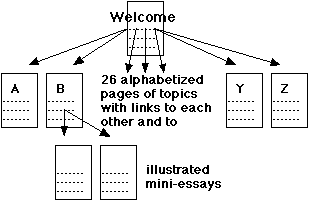
(This last site is by subscription only,
but has many other features and is a valuable asset for a biology department.)

A-B-C-D-E-F-G-H-I-J-K-L-M-N-O-P-Q-R-S-T-U-V-W-X-Y-Z
| The News: The Major Histocompatibility Locus (MHC) of humans has now been completely sequenced. It contains 128 working genes spread over 3,673,800 nucleotides. The Background: Read about this region on chromosome 6 in Histocompatibilty Molecules and about the role of their gene products in Transplantation Biology. |
| The News: "Smart gene" discovered! Transgenic mice that make extra amounts of NMDA receptors perform various tasks better than control mice. The Background: Read about the role of NMDA receptors in learning and memory in Long-Term Potentiation (LTP) |
| The News: 11 October 1999: Dr. Günter Blobel wins the 1999 Nobel Prize in Physiology or Medicine for his discoveries of the intrinsic signals that govern the transport and localization of proteins in the cell. The Background: Read: Protein Kinesis: Getting Proteins to Their Destination. |
| News archives |
| The human brain [November 1999] |
| Psychoactive drugs and their influence on the brain [November 1999] |
| Learning, Memory, and Long-Term Potentiation [October 1999] |
| Human diseases caused by mutations in mitochondrial DNA (mtDNA) [October 1999] |
| Update on using pigs for xenotransplantation. [October 1999] |
| Games parasites play! How some bacteria escape destruction by phagocytes. [October 1999] |

Although some of this information has been drawn from the sixth edition of the author's text Biology published in 1994 by Wm. C. Brown, every effort has been made to adapt the material to the opportunities provided by an online text:
It has always seemed to me that the many parts that make up the subject of biology are related to each other more like the nodes of a web than as a linear collection of independent topics. If so, the power of hypertext should be better suited to learning about biology than is the linear structure of a printed textbook.
Another disadvantage of printed textbooks is the inevitable delay between the time that new advances in biology are reported and the time that they can become incorporated in a printed book (often several years). Material here can be updated promptly.
To make access as speedy as possible, every effort will be made to keep file sizes as small as possible. I also have deliberately avoided some of the clever things that can be done with the latest browsers because I feel that they add little educational value in return for their cost in clarity and bandwidth.
A suggestion: open the window of your web browser to the full width of your screen for the easiest viewing when text and graphics occur side-by-side.
Italics: although italics are used often in biology, I will avoid them here because they show up so poorly on the screen.
Your comments, criticisms, and suggestions are always welcome. Send them to:
Dr. John W. Kimball
1. Click the first letter of your desired term in the alphabet at the top of this page or any of the index/glossary pages
2a. scroll down to your desired item or, alternately,
2b.Open the "Find" dialog box from your browser's tool bar and enter the word you seek. If you begin with an uppercase letter AND choose "case sensitive" or "match case", you will increase your chance of hitting the topic item itself rather than hitting the same word appearing within other items.
Note that the Find function of your browser will only work for terms beginning with the letter of the page you are on (because each alphabetized section is on a separate page).
3a.A link at the bottom of every page returns you to this welcome page (where you can then link to the first letter of a new item).
3b.Each index/glossary page also has a link ("Next Search") to the alphabet at the top of that page.
3c. You can pull down the history list ("Go" on the Netscape and Internet Explorer menus) and release on the welcome page ("Kimball's Biology Pages") or any other earlier page.
3d. If you are using a frames-capable browser, you can use the link at the top of this page ("FRAMES VERSION") to place a clickable alphabet that will remain at the top of each window.
| Return to top of page |
John W. Kimball has recently retired from a lifetime of teaching biology. A graduate of Harvard College, he began his teaching career at the secondary level, teaching chemistry and biology to students at Phillips Academy, an independent school in Andover, Massachusetts. In 1969, he returned to Harvard to study immunology with the late Professor A. M. Pappenheimer. After receiving his Ph.D. there, he went on to teach introductory biology (in both majors and nonmajors courses) and immunology at Tufts University where he became a tenured professor. In 1982 he returned again to Harvard where he taught immunology and also participated in teaching the introductory course for majors.
 The first edition of Kimball's general biology text was published in 1965. Since that time it has gone through five revisions, the most recent being the sixth edition, which appeared in 1994 (that's its cover on the right). He has also published books on cell biology and a widely-used text on immunology. His biology books have also been published in Spanish, German, Japanese, Arabic, Polish, Korean and Bahasian (Indonesian) versions.
The first edition of Kimball's general biology text was published in 1965. Since that time it has gone through five revisions, the most recent being the sixth edition, which appeared in 1994 (that's its cover on the right). He has also published books on cell biology and a widely-used text on immunology. His biology books have also been published in Spanish, German, Japanese, Arabic, Polish, Korean and Bahasian (Indonesian) versions.